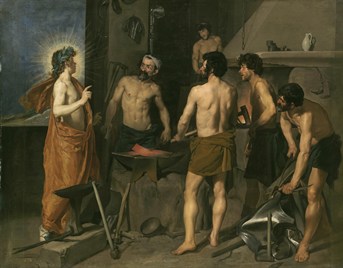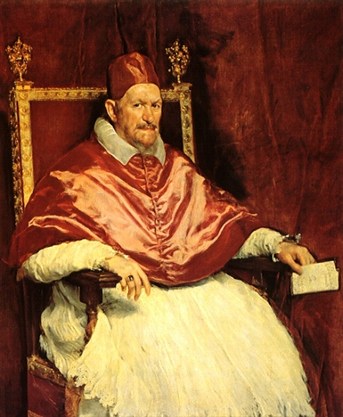Trips to Italy by Diego Velázquez
 In 1629 the main artist of the Siglo de Oro, Diego Rodríguez de Silva y Velázquez, obtained the necessary funding to undertake his long-awaited first study trip to Italy from the Spanish king Philip IV, which represented a pivotal experience for the development of his style. The aim was to “improve in his profession” and “to participate in the grave harvest” of works of art. After stopping in Genoa, in the wake of the new governor of Milan, Ambrogio Spinola, the painter stopped in Milan, Parma and Venice, where he admired the works of Titian and Tintoretto. Then it was the turn of Ferrara, Cento, Loreto and Rome, where he arrived in October 1630 and stayed a year. Here he studied the Bamboccianti, Classicist painters such as Domenichino, Reni, Guercino and Poussin, and the Neo-Venetians such as Bernini and Pietro da Cortona. Thanks to his friendship with Monsignor Giovanni Battista Pamphili, former nuncio in Madrid, and the Count of Monterrey, the ambassador of the Catholic King, he was able to visit the Sistine Chapel, the Vatican palaces and private collections of paintings and antique marbles. In 1630 he executed Apollo in the Forge of Vulcan (Madrid, Prado, image 1), which summarized the experiences assimilated in the those months, and the Brawl at the Embassy of Spain in the Pallavicini collection, a picture rediscovered by Roberto Longhi. In 1631 he moved to Naples, where he met fellow countryman Ribera, called “the little Spaniard”. Back in Spain, he was given new duties at court, where he energetically resumed his activities as official court painter, showing that he had assimilated important models such as Titian and Rubens, treated with a more transparent and more dynamic luminosity.
In 1629 the main artist of the Siglo de Oro, Diego Rodríguez de Silva y Velázquez, obtained the necessary funding to undertake his long-awaited first study trip to Italy from the Spanish king Philip IV, which represented a pivotal experience for the development of his style. The aim was to “improve in his profession” and “to participate in the grave harvest” of works of art. After stopping in Genoa, in the wake of the new governor of Milan, Ambrogio Spinola, the painter stopped in Milan, Parma and Venice, where he admired the works of Titian and Tintoretto. Then it was the turn of Ferrara, Cento, Loreto and Rome, where he arrived in October 1630 and stayed a year. Here he studied the Bamboccianti, Classicist painters such as Domenichino, Reni, Guercino and Poussin, and the Neo-Venetians such as Bernini and Pietro da Cortona. Thanks to his friendship with Monsignor Giovanni Battista Pamphili, former nuncio in Madrid, and the Count of Monterrey, the ambassador of the Catholic King, he was able to visit the Sistine Chapel, the Vatican palaces and private collections of paintings and antique marbles. In 1630 he executed Apollo in the Forge of Vulcan (Madrid, Prado, image 1), which summarized the experiences assimilated in the those months, and the Brawl at the Embassy of Spain in the Pallavicini collection, a picture rediscovered by Roberto Longhi. In 1631 he moved to Naples, where he met fellow countryman Ribera, called “the little Spaniard”. Back in Spain, he was given new duties at court, where he energetically resumed his activities as official court painter, showing that he had assimilated important models such as Titian and Rubens, treated with a more transparent and more dynamic luminosity.
 Over the years, the painter got more and more prestigious positions until being appointed superintendent of the royal works, hence inspector and administrator. Envy and jealousy drove him in October 1648 to undertake a second trip to Italy along with the Duke of Nájera y Maqueda who was going to go to Trent to receive Mariana of Austria, the future wife of Philip IV. The official purpose of this second trip was to buy paintings and antique statues for the royal collections, as well as to copy famous works and obtain Italian fresco painters to be used for the Alcázar (after the rejection of Pietro da Cortona, Velázquez was able to convince the painters from Bologna Angelo Michele Colonna and Agostino Mitelli to follow him to Madrid). In Venice, in 1649, he bought paintings by Veronese and Tintoretto. While in Rome, where he arrived in the Summer of 1649, he was received with great favor by the papal court by the new pro-Spanish Pope, Innocent X Pamphili, whom he portrayed the following year (Rome, Galleria Doria Pamphili, image 2). The painting, which ushered in the third phase of the Sevillian artist’s career, captured the sullen and suspicious character of the pontiff, who was impressed by the brilliance of the color of the impasto and gave him a medal and a gold chain. Also in Rome, in 1650, the artist painted the portrait of his servant, Juan de Pareja (New York, Metropolitan Museum), one of his most popular works, which granted him admission to the prestigious Accademia di San Luca. After a visit to Ribera in Naples, Velazquez returned to Spain in 1651, bringing with him as many as three hundred paintings and statues.
Over the years, the painter got more and more prestigious positions until being appointed superintendent of the royal works, hence inspector and administrator. Envy and jealousy drove him in October 1648 to undertake a second trip to Italy along with the Duke of Nájera y Maqueda who was going to go to Trent to receive Mariana of Austria, the future wife of Philip IV. The official purpose of this second trip was to buy paintings and antique statues for the royal collections, as well as to copy famous works and obtain Italian fresco painters to be used for the Alcázar (after the rejection of Pietro da Cortona, Velázquez was able to convince the painters from Bologna Angelo Michele Colonna and Agostino Mitelli to follow him to Madrid). In Venice, in 1649, he bought paintings by Veronese and Tintoretto. While in Rome, where he arrived in the Summer of 1649, he was received with great favor by the papal court by the new pro-Spanish Pope, Innocent X Pamphili, whom he portrayed the following year (Rome, Galleria Doria Pamphili, image 2). The painting, which ushered in the third phase of the Sevillian artist’s career, captured the sullen and suspicious character of the pontiff, who was impressed by the brilliance of the color of the impasto and gave him a medal and a gold chain. Also in Rome, in 1650, the artist painted the portrait of his servant, Juan de Pareja (New York, Metropolitan Museum), one of his most popular works, which granted him admission to the prestigious Accademia di San Luca. After a visit to Ribera in Naples, Velazquez returned to Spain in 1651, bringing with him as many as three hundred paintings and statues.
